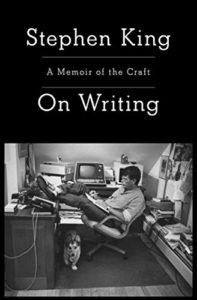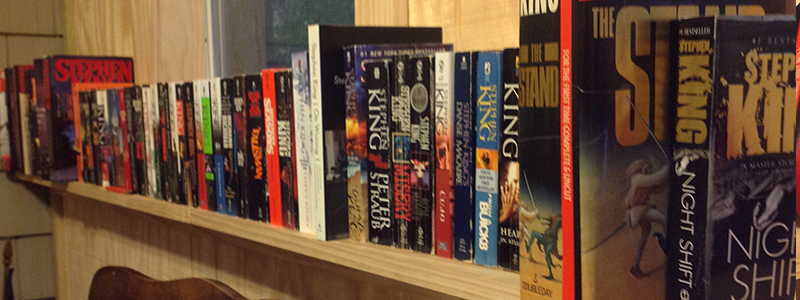by Jay Wilburn
The plan is to reread all of Stephen King’s works in the order that they were published. Richard Chizmar of Cemetery Dance had the vision. I’m doing it because I am a writer and I want to improve my fiction. And I love Stephen King’s stories. I think there is something to be learned through this process.
You can also go back to the beginning and read Before Carrie or any of my other posts up through this one and beyond by checking out this link to the Master List of all my #StephenKingRevisited posts.

Come at it any way you like, but don’t come to the blank page lightly.
I could spend this entire post just listing off my favorite lines and pieces of advice from On Writing by Stephen King. I’m doing a little of that, but I’ll try to restrain myself. I should revisit this work regularly. He says the book is short because writing books are full of bullshit. Omit needless words, he advises.
We have entered the year 2000 in Stephen King’s catalog of work. A lot that I learned about King in the biographical sections of this book after reading it the first time is revealed in his earlier work leading up to revisiting this work again in its order. The 2010 anniversary edition I have includes an additional book list from the one in the first printing.
His description of the submission process for short stories and the “road up” is a little dated, but still pretty good for 20 years on.
He wrote the first half of the first draft in 1997. The work remained roughly half finished for 18 months. He started back up on it in earnest in June of 1999 before the accident. The van accident that nearly killed him is described in brilliant detail. Maybe some of his best nonfiction writing ever. After being struck, he sat down five weeks later to finish this book. The accident in 1999 changed future drafts significantly. He even mentions it in discussions of his childhood traumas before he gets to the narrative of the accident itself. He was still in the midst of his hard recovery as he finished this book.
King firmly rejects the idea of a through-line in this story.
His dad leaving him young impacted him in unique ways. He revealed more about that back in the writing of Dance Macabre, a book on horror in all media that still holds up today. His brother is deeply important to him and it is reflected in how well he writes brotherly relationships in his work, especially between young brothers.
It is my strong impression that Dance Macabre and On Writing represent key moments in King’s career and life. Both these nonfiction books explore horror and the writing of it. He agreed to write them for their stated purposes of cataloging their subjects and both do a great job of it. I think King agreed to write them partly to work out his own search for what was next for him as an author. The work that follows Dance Macabre uses the tropes and ideas he fleshes out in that work. The novel It may be the culmination of that exploration.
With On Writing, I think maybe he was searching for the kind of work he wanted to do in the new century, not knowing how much time he might have left. The van accident may have cemented that sense of mortality more than everything else leading up to it. Following this work, he eventually finishes The Dark Tower series one volume after the other. Other great works follow.
King laments that among all the questions he is asked, no one ever asks about the language. An off-handed conversation involving this lament on the road with his blues band of writers led to the creation of this book in the first place. Or at the very least, it spurred King to go ahead with the notion that had been rolling around his head for a while.
The editor is always right, but never take all their advice. Rewrites are taking out everything that is not the story. Write with the door closed, but rewrite with the door open.
There is a good grammar and usage review section right after he says he isn’t going to include such a section. The road to hell is paved in adverbs, he warns. Then, he admits he still doesn’t cut out as many as he should.
He sees the imagination as the revelation of more doors than anyone could open in a lifetime. The implied challenge seems to be to open as many as you can in the time you have. The story starts in the writer’s imagination and ends in the reader’s. There needs to be a happy median between description that is too thin and description so thick that buries the reader in details. He says that description of setting is more important for immersing the reader than physical description of the characters and certainly not wardrobe.
King breaks down stories into narrative, description, and dialogue, but no plot. He claims plotting is a good writer’s last resort and the dullard’s first choice.
The “skin book” original ending for Misery he describes sounds better to me. I still love that book. Insomnia and Rose Madder are plotted books, King says. He thinks they suffered for that fact. I think Rose Madder is one of his more underrated books. Insomnia he might be right about. He says The Stand is his most loved and unifying work among readers. He finds something a little depressing about a unified opinion that your best work was over 20 years ago. Longer now. Sword in the Darkness sounded pretty good. What ever happened to that one?
King places himself among the last group of American novelists who learned to read and write before they saw television.
He admits that once you have a little success, magazines are less apt to tell you your submission is “not for us.”
Readers’ and writers’ first impressions of a character are likely to be wrong.
Don’t stop a work just because it is hard. Fear is at the root of most bad writing, he tells us.
King rails against flashbacks because they are a break in the action. He is invested in what is going to happen, not what did. *looks at The Dark Tower series on the shelf* *pulls out Wizard and Glass from that series and waves it in the air* Come on, man. This whole book was one long flashback. These were my complaints! What the hell?! He does say in the course of this book that some of these items are “do as I say, not as I do.” Fair enough.
Stephen King maps out his typical writing day as of the time of this book. Morning is for writing; afternoons are for naps and letter writing; and evenings are for reading, Red Sox games, and family. He admits he will take on revisions in the evening that just won’t wait.
King says to put your desk in the corner and remind yourself why it isn’t in the middle of the room. Life isn’t a support system for art. It’s the other way around.
I finished the reread in two days and at first I couldn’t recall why it took me so long to finish it the first time. It probably had something to do with the first time I read it I had just quit my job to start writing full-time. I felt overwhelmed by the amount of important information. Rereading it over seven and a half years into full-time writing for a living, a good bit of the good stuff felt second nature and I felt like I was refreshing the important information.
Anyone taking on writing in a serious way would benefit from reading this work. There is a universe more in this short book that I didn’t even touch on. Explore it for yourself.
My next post in this series will be Before Dreamcatcher which will be linked on the Master List of all my Stephen King Revisited posts.





